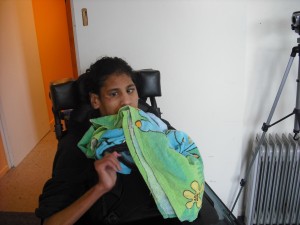Eddie is a 16 year old student with low vision, Cortical Vision Impairment and complex needs. He is enrolled with the Correspondence School of New Zealand.
Eddie’s learning involves community activities and experiences. Travel to and from these activities have often resulted in Eddie being upset and unsettled.
Jo Mather his Resource Teacher of Vision talks about how real objects with verbal prompts/signs have helped to settle him. In figure 1 Eddie is touching a towel before his swim time.
What is happening now?
The real objects that were introduced included a towel for swimming before Eddie went swimming, looking at the horse/mane before Eddie went for a ride and looking/touching keys before a ride in the van.
Eddie appeared calmer before and after his activities throughout his day. He also began to anticipate an activity such as smiling before he went swimming.
As Eddie is in a wheelchair, smaller more portable objects of reference were needed (that could hang at the back of his chair). Eddie is beginning to look at, feel and associate smaller more abstract objects of reference to represent each activity.
Figure 2 shows Eddie looking at a flashing ring before activities in the sensory room.
Prerequisite skills
- Visual attention, location and fixation (through visual efficiency tasks integrated into his day to day routines and objects/resources used).
- Tactile skills (through daily activities that encourage exploring with hands).
- Reach with hands (through motivating activities that involve hand movement).
In Figure 3 Eddie is using both his hands to paint and explore.
Possible next steps
- Putting Eddie’s objects of reference onto a tactile timetable (generalising)
- Adding other objects to represent sleep time and going to the market.
- Photographs of Eddie’s objects of reference to develop 3D to 2D association.
- Developing Eddie’s learning into choosing one of two items, eg; swim or walk
Teaching methods and strategies
- Presenting the object just before the activity.
- Allowing time for Eddie to look and explore.
- Changing the object if needed
- Being consistent with presenting the object, verbal cue, time margin every time before the allocated activity.
- Ensuring and coordinating the team around Eddie in using the same cues with objects of reference.
Learning adaptations
- Experimenting with objects to see what objects were eye catching for Eddie.
- Holding items closely and on Eddie’s left side (best position for Eddie to locate and fix).
- Using a multisensory approach of a verbal prompt, sign and then object of reference before activity.
Assessment
- Eddie’s mum, TA and whanau observations and knowledge of Eddie.
- Eddie’s body language (anticipation, happiness, contentedness, involvement). Eddie is more settled in the van and has begun smiling, vocalising and kicking his feet when the piece of towel/ swim object of reference is shown/felt.
- Eddie is due for a full assessment with the Homai National Assessment team and we are waiting to hear back about when this will be scheduled.
Professional Readings and Resources
- Early communication for children with complex needs – Hemihelp website.
- Tactile Symbols Directory to Standard Tactile Symbol List – Texas School for the Blind website.
- Objects of Reference – Total Communication website.
- Multi-Sensory Referencing and Objects of Reference – Talksense website.
- Tactile Schedules and Calendar Boxes – Visual Impairment with Multiple Exceptionalities website.
- Communication Matters – Objects of Reference website.
More information
Email us at BLENNZ Online for more information about this subject.
We will link you up with either the author of this post or another BLENNZ colleague with whom you can continue your conversation.



